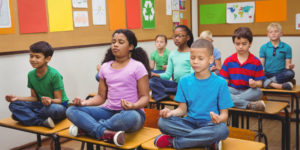Improve the Emotional and Psychosocial Quality of Life of Grammar School Children with Yoga
By John M. de Castro, Ph.D.
“Studies show that mindfulness- and yoga-based skills, conscious breath work, and body awareness improve academic performance and emotional regulation. Mindfulness-based practices also reduce anxiety and increase attention. . . . Research also reveals that mindfulness strategies enhance executive function in kids, supporting positive behavioral changes. In addition, a yoga practice promotes confidence and strength along with compassion and self-acceptance.” – Kimberly Jordan Allen
Yoga practice has been shown to have a large number of beneficial effects on the psychological, emotional, and physical health of the individual and is helpful in the treatment of mental and physical illness. The acceptance of yoga practice has spread from the home and yoga studios to its application with children in schools. Studies of these school programs have found that yoga practice produces a wide variety of positive psychosocial and physical benefits.
Teachers also note improvements in their students following yoga practice. These include improved classroom behavior and social–emotional skills, concentration, mood, ability to function under pressure, social skills, and attention and lower levels of hyperactivity. In addition, school records, academic tests have shown that yoga practice produces improvements in student grades and academic performance. This, in turn, improves the classroom experience for the teachers. Hence there are very good reasons to further study the effects of yoga practice in school on grammar school children.
In today’s Research News article “Effect of mindfulness and yoga on quality of life for elementary school students and teachers: results of a randomized controlled school-based study.” (See summary below or view the full text of the study at: https://www.ncbi.nlm.nih.gov/pmc/articles/PMC5903833/ ), Bazzano and colleagues recruited third grade students who screened positive for symptoms of anxiety and randomly assigned them to receive either an 8-week yoga/mindfulness training or to a no-treatment control condition. The yoga program occurred in 10 in-class 40-minute sessions and included postures, breathing exercises, and relaxation. The students were measured at the beginning, middle, and end of the 8-week intervention period for life satisfaction and childhood quality of life including physical, emotional, social, and school domains. In addition, teachers were measured for health-related quality of life.
They found that in the middle and after the yoga/mindfulness intervention the students had significant improvements in psychosocial and emotional quality of life. The teachers reported that after the program they were significantly more likely to include yoga practice in their classrooms. Hence, the brief yoga/mindfulness program was successful in improving the social and emotional life conditions for the children and these improvements were sufficiently noticeable that the teachers decided to continue employing yoga practice in the classroom after the program was completed.
These results are encouraging and suggest that even at a relatively young age and early in children’s school life practicing yoga in school improves their and their teachers’ lives. It should be noted that the comparison condition did not include any treatment. In future research an active control condition such as aerobic exercise should be included to determine if the effects are specific for yoga practice or might occur with any exercise program. Regardless, the program helped to improve the lives of anxious young students.
So, improve the emotional and psychosocial quality of life of grammar school children with Yoga.
“Yoga in my classroom creates a sense of community. They are more of a unified group. Something about yoga brings the students together, almost like team building.” – YogaCalm
CMCS – Center for Mindfulness and Contemplative Studies
This and other Contemplative Studies posts are also available on Google+ https://plus.google.com/106784388191201299496/posts and on Twitter @MindfulResearch
Study Summary
Bazzano, A. N., Anderson, C. E., Hylton, C., & Gustat, J. (2018). Effect of mindfulness and yoga on quality of life for elementary school students and teachers: results of a randomized controlled school-based study. Psychology Research and Behavior Management, 11, 81–89. http://doi.org/10.2147/PRBM.S157503
Abstract
Objective
To assess the impact of a yoga curriculum in an elementary school on student quality of life, and to assess teacher and staff perception of potential barriers to, and benefits of, introducing yoga and mindfulness into the classroom.
Methods
A randomized controlled trial was utilized to assess the impact of a brief intervention on third-grade students who screened positive for symptoms of anxiety. Students were randomized to an intervention group of 20 students receiving small-group yoga/mindfulness activities for 8 weeks between October 2016 and February 2017, and a control group of 32 students receiving care as usual. The Brief Multidimensional Students’ Life Satisfaction Scale-Peabody Treatment Progress Battery and the Pediatric Quality of Life Inventory (PedsQL) served as outcomes. Teachers were invited to participate in two professional development sessions about introducing yoga and mindfulness into the classroom, and completed a survey following each of the sessions.
Results
In generalized estimating equation models adjusted for time, the yoga-based intervention was associated with a 14.17 unit increase in student emotional PedsQL (p-value 0.001) and a 7.43 unit increase in psychosocial PedsQL (p-value 0.01). Results were not attenuated by adjustment. Teachers and staff reported using yoga more frequently in the classroom following the second of two professional development sessions (p-value <0.05). Perceived barriers to introducing yoga to the classroom were similar at two data collection time points, while perceived benefits remained high.
Conclusion
The intervention was associated with a significant improvement in emotional and psychosocial quality of life in the intervention group when compared to the control group, suggesting that yoga/mindfulness interventions may improve symptoms of anxiety among students. Yoga/mindfulness activities may facilitate stress management among elementary school students and may be added as a complement to social and emotional learning activities.
https://www.ncbi.nlm.nih.gov/pmc/articles/PMC5903833/
